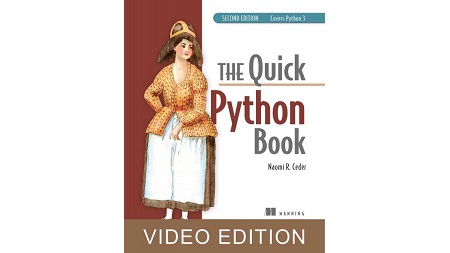
English | MP4 | AVC 1280×720 | AAC 44KHz 2ch | 9h 40m | 1.49 GB
The Quick Python Book offers a clear, crisp introduction to the elegant Python programming language and its famously easy-to-read syntax. Made for programmers new to Python, this edition covers features common to other languages concisely, while introducing Python’s comprehensive standard functions library and unique features in detail.
After exploring Python’s syntax, control flow, and basic data structures, the book shows how to create, test, and deploy full applications and larger code libraries. It addresses established Python features as well as the advanced object-oriented options available in Python 3. Along the way, you’ll survey the Python development landscape, including GUI programming, testing, database access, and web frameworks.
Inside:
- Concepts and Python 3 features
- Regular expressions and testing
- Python tools
- All the Python you need—nothing you don’t
Table of Contents
01 About Python
02 Python is complete—“batteries included”
03 What Python doesn’t do as well
04 The IDLE integrated development environment
05 Getting started
06 The Quick Python overview
07 Tuples
08 The for loop
09 The absolute basics
10 Numbers
11 Lists, tuples, and sets
12 Sorting lists
13 Tuples
14 Strings
15 String methods
16 Modifying strings
17 Converting from objects to strings
18 Formatting strings with %
19 Dictionaries
20 Word counting
21 Control flow
22 List and dictionary comprehensions
23 Boolean values and expressions
24 Functions
25 Local, nonlocal, and global variables
26 Modules and scoping rules
27 The module search path
28 Python scoping rules and namespaces
29 Python programs
30 Making a script directly executable on UNIX
31 Scripts on Windows vs. scripts on UNIX
32 Distributing Python applications
33 Using the filesystem
34 The current working directory
35 Getting information about files
36 Reading and writing files
37 Screen input_output and redirection
38 Pickling objects into files
39 Exceptions
40 Exceptions in Python
41 Debugging programs with the assert statement
42 Classes and object-oriented programming
43 Class variables
44 Inheritance
45 Using @property for more flexible instance variables
46 Destructors and memory management
47 Graphical user interfaces
48 Principles of Tkinter
49 Creating widgets
50 What else can Tkinter do
51 Regular expressions
52 Extracting matched text from strings
53 Packages
54 import statements within packages
55 Data types as objects
56 Advanced object-oriented features
57 Giving an object full list capability
58 Metaclasses
59 Testing your code made easy(-er)
60 Chapter 21 Using unit tests to test everything, every time
61 Moving from Python 2 to Python 3
62 Using 2to3 to convert the code
63 Using Python libraries
64 Installing Python libraries using setup.py
65 Network, web, and database programming
66 Creating a Python web application
67 Sample project—creating a message wall
Resolve the captcha to access the links!